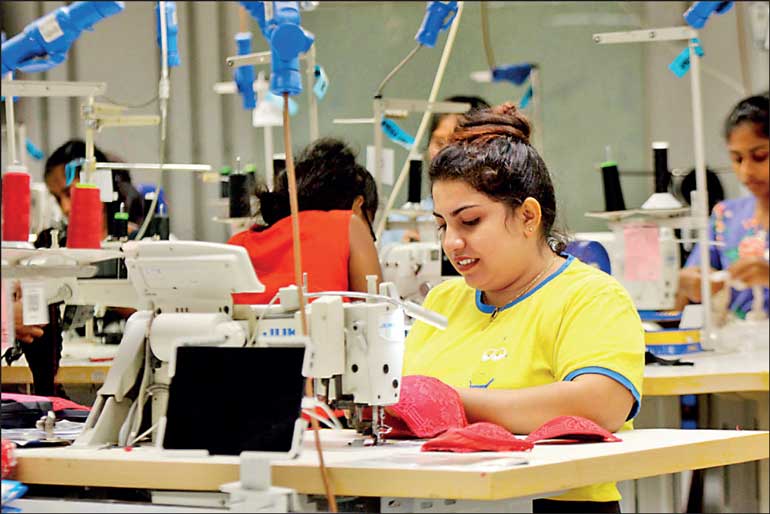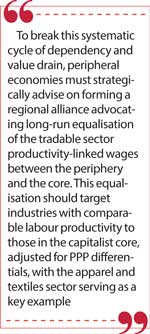Saturday Dec 27, 2025
Saturday Dec 27, 2025
Tuesday, 28 October 2025 00:24 - - {{hitsCtrl.values.hits}}

The garments and apparel sector in Sri Lanka provides a stark and concrete illustration of unequal exchange, specifically the transfer of value through wage differentials
 The alluring façade of capital accumulation in the global ‘core’ economies conceals a cruel reality. Its sustained prosperity is predicated on the vast systematic appropriation of labour and resources from the Global South’s peripheries and semi-peripheries. In the contemporary world, this colossal appropriation of value is orchestrated primarily through the mechanism of ‘unequal exchange in international trade’.
The alluring façade of capital accumulation in the global ‘core’ economies conceals a cruel reality. Its sustained prosperity is predicated on the vast systematic appropriation of labour and resources from the Global South’s peripheries and semi-peripheries. In the contemporary world, this colossal appropriation of value is orchestrated primarily through the mechanism of ‘unequal exchange in international trade’.
Power asymmetry and value transfer
Core states and firms leverage their overwhelming geopolitical and commercial dominance to systematically compress wages, prices, and profits in the Global South. This effect is visible both across national economies and, critically, within global commodity chains that drive over 70% of world trade, shown by recent studies of Jason Hickel, Morena Lemos, and Felix Barbour in ‘Nature Communications’. This results in a world economy where Southern prices are systematically lower relative to their Northern counterparts, forcing Southern states and producers to export ever-increasing amounts of labour and resources, embodied in their traded goods, just to afford a comparatively lower intrinsic value of imports at higher monetary costs. This dynamic enables Northern economies to net-appropriate value, year after year, delivering enormous unearned benefits to Northern capital and consumers.
Insight of Marx
The theory of unequal exchange finds its intellectual genesis in the unfinished but profound work of Marx on international trade. Far ahead of his time, Marx conceptually anticipated what is now known as the Penn Effect and the foundational logic of Purchasing Power Parity (PPP). Long before the emergence of systematic work on PPP during World War I, or the tongue-in-cheek creation of the Big Mac index in 1986, Marx observed the inherent global inequality in value expression.
As noted by Andrea Ricci, a foremost theorist in the field, Marx pointed out that ‘different quantities of commodities of the same kind, produced in different countries in the same working time have unequal international values, which are expressed in different prices. The relative value of money will, therefore, be less in the nation with a more developed capitalist mode of production than in the nation with less developed’. This reflects the inequality of prices and expression of value of similar goods under different conditions of national development.
 Marx extended this insight into a theory of international value transfer. Contrary to classical trade theory that emphasises mutual benefits through comparative advantage, Marx argued that the international market mechanism would inevitably draw value from the underdeveloped nations towards the capitalist core, through trade between the two regions. This structural drain is driven by the concentration of capital-intensive production in the core and labour-intensive production in the periphery. In his ‘Grundrisse’, Marx explicitly detailed this mechanism of global appropriation. ‘From the possibility that profit may be less than surplus value (this is predicted to happen in labour-intensive sectors), it follows that also nations may continually exchange with one another, without necessarily gaining in equal degrees.
Marx extended this insight into a theory of international value transfer. Contrary to classical trade theory that emphasises mutual benefits through comparative advantage, Marx argued that the international market mechanism would inevitably draw value from the underdeveloped nations towards the capitalist core, through trade between the two regions. This structural drain is driven by the concentration of capital-intensive production in the core and labour-intensive production in the periphery. In his ‘Grundrisse’, Marx explicitly detailed this mechanism of global appropriation. ‘From the possibility that profit may be less than surplus value (this is predicted to happen in labour-intensive sectors), it follows that also nations may continually exchange with one another, without necessarily gaining in equal degrees.
One of the nations may continually appropriate for itself a part of the surplus labour of the other, giving back nothing for it in the exchange’. He explains that while two nations may engage in mutually profitable trade, they do not necessarily gain in equal degrees. When labour-intensive sectors trade with capital-intensive sectors, the functioning of the international price system, driven towards an average rate of profit under competitive conditions, results in an unearned surplus being realised by capital-intensive core economies.
This structural tendency is powerfully reinforced by the market reality. Global North firms, with monopoly access to tremendously vast domestic markets and financial power, wield disproportionate strength in setting and controlling tradable sector prices and wages of the global South. This in turn intensifies and accelerates the systemic transfer of unearned value that exists in competitive conditions.
No debt, no full employment
The consistent outflow of value deprives the periphery of the requisite capital to achieve full employment without an escalating reliance on foreign borrowing. This dynamic is reinforced by the labour-intensive character of most economies in the Global South, where capital inflows to the region predominantly manifest as international payments to labour (wages) rather than profits or direct foreign investments. Therefore, the tremendous disparity in wages for identical work performed between advanced and underdeveloped economies robs them of non-debt inflows to the latter, rendering third-world debt crises and its long-term currency depreciation systemic features of international trade under capitalism.
Dynamics of unequal exchange intensified in the 1980s and 1990s through the imposition of structural adjustment programmes (SAPs) across the global South. SAPs forced Southern governments to devalue currencies, cut public employment, and removed labour and environmental protections, depressing wages and export prices. Political economists emphasise that SAPs also curtailed independent industrial policy and state-led technological progress and compelled Southern governments to prioritise ‘export-oriented’ production in highly competitive sectors and in subordinate positions within global commodity chains.
Simultaneously, lead firms in the core states seized the opportunity to shift industrial production Southward to take direct advantage of cheaper labour, while leveraging their control over global commodity chains to squeeze the wages and profits of Southern producers. These coordinated interventions have boosted the North’s purchasing power over Southern labour and goods.
New estimates of the extortion
The revival of studies on unequal exchange theory during the last decade has introduced new methods for estimating the staggering scale of this surplus transfer. The mechanism is essentially the appropriation of rent incomes stemming from lower payments to labour and capital in the global South for work equivalent to that performed in the capitalist core. These value transfers emerge through historically established inequality in wage rates and profits between the capitalist core and the rest of the world through colonial conquest and subjugation, the monopolistic position in trade occupied by the metropolitan economies and through the impersonal workings of international markets which tends to depress the prices of both labour intensive and primary products below their intrinsic value, of goods produced in the global South. In his ‘Value and Unequal Exchange in International Trade’, the seminal work published in 2021, Andrea Ricci formalised these different mechanisms of unequal exchange scattered throughout literature and introduced the means of estimating the monetary extent of the loss to the global South in its totality.
 His estimations show over 70% of the value appropriated is derived through the wage differential between the two regions, while the rest is extracted through profit differentials. Focusing on the extent of value transfer solely through inequality of wages, the recent work by Jason Hickel et al (2024) reveals the colossal scale of this value transfer. Global North economies net-appropriated 826 billion hours of embodied labour from the global South across all skill levels and sectors. The wage value of this net-appropriated labour was equivalent to a staggering Euro 16.9 trillion in Northern prices (before adjusting for purchasing power parity), accounting for all skill levels.
His estimations show over 70% of the value appropriated is derived through the wage differential between the two regions, while the rest is extracted through profit differentials. Focusing on the extent of value transfer solely through inequality of wages, the recent work by Jason Hickel et al (2024) reveals the colossal scale of this value transfer. Global North economies net-appropriated 826 billion hours of embodied labour from the global South across all skill levels and sectors. The wage value of this net-appropriated labour was equivalent to a staggering Euro 16.9 trillion in Northern prices (before adjusting for purchasing power parity), accounting for all skill levels.
Hickel et al (2024) show that this appropriation roughly doubles the labour that is available for Northern consumption but drains the South of productive capacity that could be used for local needs and development. They emphasise that unequal exchange is in part driven by systematic wage inequalities, given that Southern wages are 87-95% lower than Northern wages for work of equal skill. While Southern workers contribute 90% of the labour that powers the world economy, they receive only 21% of global income.
Plight of Sri Lanka’s garments and apparel sector
The garments and apparel sector in Sri Lanka provides a stark and concrete illustration of unequal exchange, specifically the transfer of value through wage differentials. The garments trade provides an easy entry point towards estimation and comparison given that it is a manufacturing activity found in both core (although less well-known) and the periphery while maintaining enormously unequal wage rates. For instance, a garment sector worker in the United States earns approximately $ 15.5 per hour (U.S. Bureau of Labour Statistics 2023), whereas a worker in Sri Lanka performing the same task would receive $ 0.73 per hour. Adjusting for PPP exchange rate of 3.34 using World Bank’s PPP data for 2024, the PPP-adjusted hourly wage is $ 2.46 per hour – less than one-sixth of the US equivalent, despite a comparable technological level in production.
This disparity cannot be explained by differences in work intensity, which is often higher in third-world economies. Consider Sri Lanka’s garment factory workers who frequently report being denied adequate toilet breaks and time for drinking water during working hours. This extreme regimen compels workers to operate at a pace that sacrifices their health and well-being, allowing factory owners and ultimately Northern capital and consumers to reap the maximum surplus from every working day. Such oppressive conditions are rarely, if ever, seen in comparable production facilities in the Global North, which strongly suggests a greater intensity of exploitation in the South.
For the sake of conservative estimation, we must assume that the intensity of work is equal, even though it is clearly greater in Sri Lankan factories. Under this premise, if wage parity for equivalent work is universally applied, the foreign exchange inflow to Sri Lanka through garments sector wage payments would increase over sixfold. To put this in perspective, assuming wages constitute 40% of sectoral revenue, the total wage bill would be approximately $ 1.8 billion under current conditions as of 2024. Under a universal parity wage system, this figure would rise to an estimated $ 11 billion, indicating that $ 8.2 billion in value was transferred out of the economy through garments and apparel exports due to unequal exchange or disparity in wage rates. As Arghiri Emmanuel (1972) argued, this immense wage disparity, even in sectors with identical factor productivity, is not a product of free market forces but rather a legacy of centuries of colonial rule and imperial domination, where the highly unequal rates of exchange between the imperialist core and the periphery were enforced through coercion.
A path to collective reclamation
To break this systematic cycle of dependency and value drain, peripheral economies must strategically advise on forming a regional alliance advocating long-run equalisation of the tradable sector productivity-linked wages between the periphery and the core. This equalisation should target industries with comparable labour productivity to those in the capitalist core, adjusted for PPP differentials, with the apparel and textiles sector serving as a key example.
The success story of the Organisation of the Petroleum Exporting Countries (OPEC), based on controlling output prices of a relatively homogenous commodity, provides a relevant precedent. However, instead of attempting to set price floors to improve terms of trade, a strategy that proved unsuccessful for structuralists in the 1980s, a more feasible demand is the gradual equalisation of real wages between the core and the periphery, linked to productivity.
Given the rising economic power of the Global South, the political feasibility of such a process is now greater than in the past. This approach is more practical than attempting to control world market prices of highly differentiated products, particularly considering the downward stickiness of wages relative to prices. Sri Lanka, with a Government placed into power by the masses against the established political and economic order, is uniquely positioned to initiate and lead such a regional collective to advance the course of justice for the Global South.